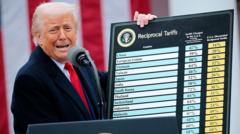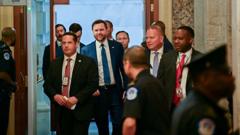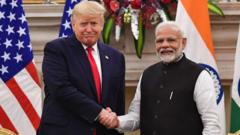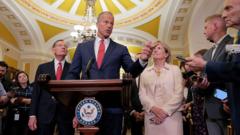In a sharp twist in U.S.-China trade relations, President Trump threatens new tariffs on Chinese electronics just days after announcing exemptions, adding uncertainty to markets and consumer electronics pricing.
Trump's Tariff Tango: New Threats Loom Amid Recent Exemptions

Trump's Tariff Tango: New Threats Loom Amid Recent Exemptions
As President Trump backtracks on tariff exemptions for electronics, global markets react amidst rising trade tensions.
Donald Trump has reignited tariff discussions, particularly targeting Chinese-made smartphones and other electronics, asserting that these items will not remain exempt from tariffs. This comes after a brief respite in which reports indicated that certain electronics could evade levies of up to 145%. Following these announcements, European stock markets showed initial gains, as investors processed the potential positive impacts of exemptions.
However, Trump's subsequent clarification on social media indicated that the electronic products would fall into a different levy's "bucket," effectively maintaining the perceived threat of tariffs. This escalation in rhetoric aligns with mounting pressure from China, which has urged the U.S. to cancel its tariff regime entirely and pursue a path of mutual respect in trade relations.
Adding to the complexity, U.S. officials announced that instead of previous tariffs, a new "semiconductor tariff" will be introduced. U.S. Commerce Secretary Howard Lutnick emphasized the need for essential goods like semiconductors and electronics to be produced domestically, citing national security concerns.
On the ground, the ramifications of this tariff uncertainty are being felt in consumer goods markets. Notably, Sony recently raised prices on its flagship PlayStation 5 in several regions, attributing the decision to a challenging economic environment. The Chinese commerce ministry characterized Trump's recent exemptions as a mere "small step," indicating that Beijing is still evaluating the broader impacts of U.S. trade policy.
Concerns are rising regarding the potential for an escalation of protectionist policies on both sides. U.S. Trade Representative Jamieson Greer suggested there are no immediate plans for direct dialogue between Trump and Chinese President Xi Jinping, highlighting the strained trade relations between the two economic powerhouses.
Trump initiated a significant tariff of 54% on Chinese imports earlier this year, climbing to the current 145% rate as tensions rose further. China's response has included a series of retaliatory tariffs, currently at 125%, reaffirming its position on countering U.S. trade actions.
The White House continues to defend tariffs as a strategic tool aimed at renegotiating unfair trade agreements and revitalizing U.S. manufacturing. However, analysts warn that the volatility induced by such tariff announcements may have long-standing effects on global trade dynamics and the interconnected economies reliant on stable trade relations.
As developments unfold, both consumers and markets brace for potential shifts in pricing and availability, with the prospect of further trade conflicts hanging over the global economic landscape.





















